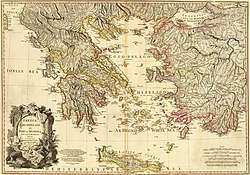| History of Greece |
|---|
 |
This is a timeline of ancient Greece from its emergence around 800 BC to its subjection to the Roman Empire in 146 BC.
Contents
- Archaic Period (785–481 BC)
- Classical Greece (480–323 BC)
- Hellenistic Greece (323–30 BC)
- See also
- References
For earlier times, see Greek Dark Ages, Aegean civilizations and Mycenaean Greece. For later times see Roman Greece, Byzantine Empire and Ottoman Greece.
For modern Greece after 1820, see Timeline of modern Greek history.